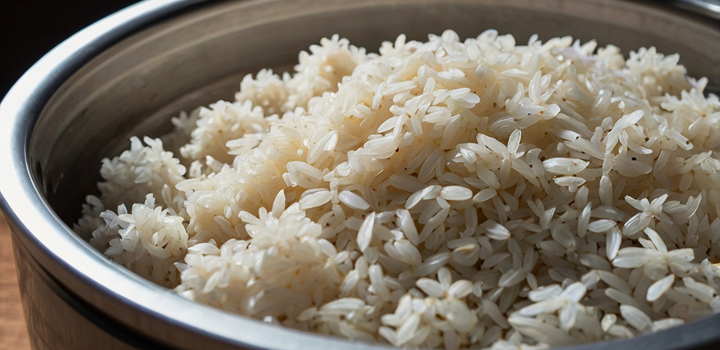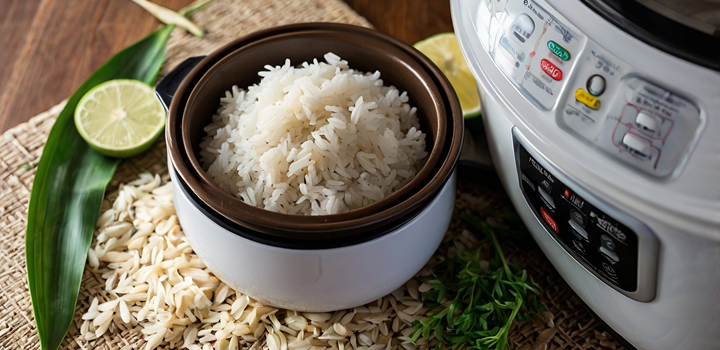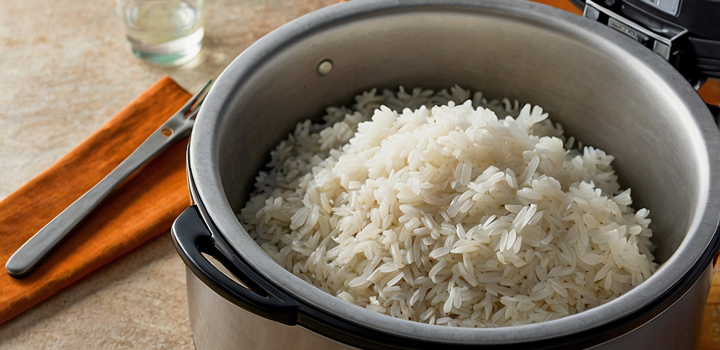How to Cook Jasmine Rice
How to Cook Jasmine Rice: Perfectly in a Rice Cooker

Arianne Nemna
Cooking jasmine rice in a rice cooker might sound simple—but getting that soft, fluffy, perfectly aromatic bowl every time takes more than just pushing a button. Jasmine rice is known for its delicate grains, gentle fragrance, and slight stickiness when done right. But it’s also surprisingly easy to over- or undercook, especially if water ratios or prep steps are off. In this guide, I’ll walk you through every stage of the process—from choosing whether or not to rinse, to measuring water correctly, to understanding why jasmine behaves differently than other white rice varieties. Whether you’re new to rice cookers or just trying to make better rice, here’s everything you need to know.
- Why Jasmine Rice Deserves Special Treatment
- Preparing the Rice for Even Cooking
- Water-to-Rice Ratios for Consistent Results
- Cooking Process
- Enhancing Flavor During Cooking
- Storage, Reheating & Use-Ahead Tips
- Using Jasmine Rice for Different Meals
- Rice Cooker Troubleshooting You Won’t Find in the Manual
- 15+ FAQs on Jasmine Rice in Rice Cookers
Why Jasmine Rice Deserves Special Treatment
Aromatic and Delicate — What Makes Jasmine Unique

Jasmine rice isn’t just any white rice. Native to Thailand, it’s a long-grain variety with a naturally floral aroma that intensifies during cooking. Unlike basmati, which stays firm and dry, jasmine softens into a slightly sticky texture without becoming mushy. That makes it ideal for Southeast Asian dishes, especially Thai stir-fries and coconut curries. Its fragrance comes from 2-acetyl-1-pyrroline, the same compound that gives pandan leaves and popcorn their signature scent. That subtle perfume is what sets jasmine apart—but it’s also what can fade if the rice is rinsed too aggressively or overcooked in excess water.
How Grain Texture Affects Water Ratio
Jasmine rice’s tender grains absorb water more readily than firmer varieties, which means it doesn’t need as much liquid to cook properly. Using the same 2:1 water ratio recommended for long-grain white rice will often lead to soggy, over-soft results. Jasmine typically calls for a 1:1 or 1:1.1 ratio in most modern rice cookers, depending on whether it’s rinsed and how soft you prefer the final texture. Because the grains swell and cling lightly together, too much water will create clumping, while too little may leave hard centers. That’s why careful water measurement—and understanding the rice’s natural absorbency—is essential.
Preparing the Rice for Even Cooking
Rinsing vs Not Rinsing – Pros and Cons

Rinsing jasmine rice before cooking is a common recommendation, but it’s not always necessary—and in some cases, it can mute the grain’s signature aroma. Rinsing removes surface starches, which can help prevent the cooked rice from turning gummy or overly sticky. It also washes away any dust or residue from packaging. However, if you rinse too thoroughly or soak it too long, some of the delicate fragrance and color can leach out, leading to a blander result.
For standard rice cookers and recipes where fluffiness is key, I do recommend a gentle rinse under cool water for 15–20 seconds, swirling lightly by hand until the water runs just barely cloudy. Avoid vigorous scrubbing or prolonged soaking. For a denser, stickier texture—say for serving with curry or grilled meats—some prefer to skip rinsing entirely, letting the starches help the grains cling.
Measuring Rice and Water with Accuracy
One of the most common reasons jasmine rice fails in a rice cooker is poor measurement. Most rice cookers come with their own plastic “rice cup”—which holds 180 ml, not a standard 240 ml US cup. If you’re using that rice cup, be consistent and use it for both rice and water. If you’re using standard measuring cups, stick with a 1:1 ratio for rinsed rice and 1:1.1 to 1.25 for unrinsed rice.
| Rice Type | Rinsed? | Water Ratio (per 1 cup rice) | Notes |
| Jasmine (rinsed) | Yes | 1 : 1 | Soft, fluffy, lightly sticky |
| Jasmine (dry) | No | 1 : 1.1 to 1.25 | Stickier, more cohesive |
Always level your dry rice when measuring. And if your rice cooker has inner line markings, those typically assume unrinsed rice—adjust accordingly if you’ve rinsed.
Water-to-Rice Ratios for Consistent Results
Standard Ratios for Common Rice Cooker Types

Most rice cookers operate on automatic heat and moisture sensors, but the water-to-rice ratio you use still determines the final result. Jasmine rice, being more tender and aromatic than many long grains, does best with slightly less water than standard white rice.
In basic on/off rice cookers, I use a 1:1 ratio for rinsed jasmine and 1:1.1 for unrinsed rice. For digital rice cookers with fuzzy logic or “quick rice” settings, I often reduce water by a tablespoon or two per cup of rice, since these machines optimize moisture retention during the cooking cycle. If you’re using a multi-cooker (like Instant Pot on rice mode), stick to 1:1 rinsed, and always account for any sautéing beforehand that may change water absorption.
The cooker’s internal markings are helpful, but they often assume short- or medium-grain rice, and sometimes slightly overhydrate jasmine if used without adjustment.
Ratio Troubleshooting Table
When jasmine rice turns out too sticky, too dry, or unevenly cooked, it’s usually a water ratio issue. Here’s how I troubleshoot based on the result:
| Final Texture Problem | Likely Cause | Adjustment for Next Batch |
| Too sticky / gummy | Too much water or no rinse | Reduce water by 1–2 tbsp per cup |
| Undercooked / firm center | Too little water or cold start | Add 2 tbsp more water; preheat pot |
| Wet top layer, dry bottom | Lid steam condensation | Fluff immediately and rest uncovered |
| Uneven grains / hard spots | No rinse or quick cycle | Rinse briefly and use standard cycle |
By tracking how your rice behaves in your specific cooker, you can dial in your perfect ratio in just a couple of batches.
Cooking Process
Preheat, Cook, and Steam — Rice Cooker Settings

Once rice and water are in the cooker, resist the urge to stir or open the lid. Jasmine rice cooks best when left undisturbed. In on/off cookers, the process is automatic—simply press the button and wait for the “warm” cycle to trigger. In digital models, select the “white rice” setting, not “quick rice,” as the latter often skips the crucial steaming phase and yields inconsistent texture.
Some cooks like to preheat the pot with a little oil before adding rice and water. While that works well for fried rice or bolder dishes, for pure jasmine flavor I recommend adding rice directly to the cool pot with water. This ensures more even hydration from the start.
The typical cook time ranges from 22 to 30 minutes, depending on the volume and machine.
Why Letting Rice Rest Makes It Fluffy
After the cook cycle finishes, jasmine rice benefits from resting with the lid closed for at least 10 minutes. This phase allows residual steam to finish hydrating any firm grains, relaxes the structure of the rice, and improves fluffiness. Skipping the rest period leads to wet clumps and broken grains when you try to fluff.
During this rest, I turn off the “keep warm” function if it’s present. Leaving it on too long can cause the bottom layer to harden or even crisp into a crust. Once rested, fluff the rice gently with a rice paddle or fork, lifting from the sides and turning—not mashing.
Enhancing Flavor During Cooking
Adding Salt, Oil, or Aromatics

Jasmine rice has a naturally sweet, nutty aroma, and it shines best when kept simple. But with care, you can enhance its depth without masking its delicate character. A pinch of kosher salt in the water before cooking will balance the flavor—about ¼ teaspoon per cup of dry rice is plenty. It’s enough to amplify the natural taste without making the rice salty.
Adding a neutral oil like avocado or a touch of ghee can improve texture, making the grains glossier and less sticky. Just a teaspoon per cup of rice, added before cooking, is enough. For aromatics, consider gently layering a smashed clove of garlic, bruised lemongrass, or a bay leaf on top of the rice before starting the cooker. These infuse softly and don’t overpower the jasmine.
Cooking with Broth or Coconut Milk
If you want to elevate jasmine rice into a standalone dish or side with bold flavor, cooking it in chicken broth, vegetable broth, or a half-and-half mix with coconut milk works beautifully. Broth introduces savory richness, especially in grain bowls or under grilled proteins. Coconut milk lends creamy texture and tropical sweetness, ideal for pairing with spicy or curried foods.
When using either, keep the total liquid ratio consistent. For example, 1 cup of rice = 1 cup of liquid total, which might be ½ cup water + ½ cup broth or coconut milk. Avoid using only thick coconut milk without dilution—it can leave the rice oily or undercooked.
Storage, Reheating & Use-Ahead Tips
Proper Cooling and Fridge vs Freezer Storage

Cooked jasmine rice stores well, but it must be cooled properly to avoid spoilage or sogginess. Spread the rice thinly on a baking sheet or in a wide dish right after cooking. Let it sit uncovered at room temperature no more than 30 minutes, then transfer to shallow, airtight containers.
Here’s a guide to storage duration by method:
| Storage Method | Maximum Duration | Notes |
| Fridge (sealed) | 4 to 5 days | Use within 2 days for best flavor |
| Freezer (sealed) | Up to 1 month | Freeze in thin, flat portions for quick thawing |
| Countertop | Not recommended | Avoid leaving out due to moisture and bacteria risk |
Always mark the date on containers before refrigerating or freezing to avoid guessing later.
Fluffing and Reheating for Best Texture
For reheating, your goal is to bring the rice back to its original moisture level without turning it mushy. If reheating from the fridge, sprinkle 1–2 teaspoons of water over each cup of rice and microwave loosely covered for about 1½ to 2 minutes. For stovetop, use a small pan with a tight lid over low heat and add a splash of water—warm gently while fluffing occasionally.
From frozen, don’t thaw in advance. Place the frozen rice block directly in a covered pan with a tablespoon of water and steam over low heat until loosened and fluffy again. You can also reheat rice in your rice cooker using the “keep warm” or “reheat” function if available—just add a bit of moisture first.
Using Jasmine Rice for Different Meals
Jasmine for Stir-Fries, Curries, and Rice Bowls
Jasmine rice is one of the most versatile staples in the kitchen. When cooked right, its light stickiness and fragrant softness make it ideal as a base for saucy dishes like Thai green curry or panang. Because it holds together slightly, it catches sauce without falling apart—and that’s what makes it so valuable in stir-fry bowls and layered plates.
To prepare it for stir-frying later, cook the rice as usual, then spread it on a tray to cool quickly. Use cold jasmine rice the next day for dishes like fried rice or rice omelets. This helps prevent clumping and keeps the rice from steaming itself in the pan.
Best Pairings for Asian and Non-Asian Dishes
While jasmine is native to Southeast Asia, its mild flavor and soft finish work well with a wide variety of cuisines. It pairs beautifully with grilled meats like lemongrass chicken, teriyaki salmon, or garlic pork. Outside of Asian dishes, jasmine rice also complements roasted vegetables, spiced chickpea stews, or Mediterranean tomato-based sauces.
Use it to bring gentle fragrance to dishes that need contrast, like spicy curries or earthy mushroom gravies. Because it doesn’t overpower, it fits into any meal that benefits from a warm, gently sticky grain.
Rice Cooker Troubleshooting You Won’t Find in the Manual
What to Do If Rice Cooker Doesn’t Click Off
Sometimes, especially with older or inexpensive rice cookers, the unit won’t automatically switch from “cook” to “warm” when the water is absorbed. This can be due to rice sticking to the bottom sensor or excess water mistakingly maintaining the boil. When this happens, unplug the cooker after 30–35 minutes if the rice smells cooked and isn’t bubbling anymore.
Let it sit with the lid closed for 10 minutes unplugged. Then open and test a spoonful. If it’s dry, it’s done. If still undercooked, add a tablespoon or two of hot water and let it rest another few minutes on warm.
Lid Steam Condensation & Wet Top Layer Fix
A common issue with jasmine rice in lidded cookers is a wet top layer caused by condensation dripping back onto the rice. This usually happens when the steam isn’t allowed to escape evenly, or when the rice rests too long under full heat.
To fix this, once the cooker switches to “warm,” crack the lid open slightly with a wooden spoon handle for 3–5 minutes to allow steam to escape. Then close it again for final resting. You can also gently fold the top layer of rice into the rest during fluffing to redistribute moisture. Avoid scooping from the top only, as this can leave the bottom over-dry and crusted.
15+ FAQs on Jasmine Rice in Rice Cookers
1. Do I need to rinse jasmine rice before cooking it in a rice cooker?
Rinsing helps remove surface starch that can make rice gummy, but it’s optional. A quick rinse improves texture while preserving aroma. If you prefer stickier rice, you can skip it.
2. What’s the best water-to-rice ratio for jasmine rice?
increase water slightly to 1:1.1. Digital cookers may need slightly less water than basic models.
3. Can I cook jasmine rice in a rice cooker without measuring cups?
Yes, but consistency suffers. Use the same container for both rice and water to maintain proportion. Some cookers also have internal line markers as a backup guide.
4. Why does my jasmine rice turn out mushy?
Too much water or overcooking can lead to mushy rice. Stick to the correct ratio, and let the rice rest for 10 minutes after cooking to help it settle.
5. Can I use chicken broth instead of water for jasmine rice?
Absolutely. Broth adds savory depth. Just use the same total liquid ratio (e.g., 1 cup rice to 1 cup broth) and avoid overly salty broth.
6. Why is the top of my rice wet and the bottom dry?
This is often caused by lid condensation or uneven heating. Fluff the rice immediately after cooking and let it rest with the lid cracked to release excess steam.
7. How do I keep rice from sticking to the bottom of the cooker?
Lightly oil the bottom of the pot or stir a few drops of oil into the water before starting. Also, avoid letting it sit too long on “keep warm.”
8. Can jasmine rice be used for fried rice the next day?
Yes, and it’s one of the best uses for leftovers. Spread the cooked rice thin after cooking and refrigerate. Use chilled rice to avoid clumps when stir-frying.
9. Is it okay to leave rice in the cooker overnight?
Not recommended. Cooked rice should be cooled and stored in the fridge within 1 hour. Leaving it warm for too long can lead to spoilage or bacterial growth.
10. How do I reheat jasmine rice without drying it out?
Add a splash of water (1–2 tsp per cup), then cover and microwave for 1–2 minutes. You can also reheat it on the stovetop with a lid and low heat.
11. What happens if I open the rice cooker lid too early?
Opening early can disrupt steam circulation and leave the top undercooked. Wait until the cooker finishes and rests before lifting the lid.
12. Can I freeze cooked jasmine rice?
Yes, it freezes well. Cool completely, then store in airtight containers or freezer bags. Flatten into thin layers for faster reheating.
13. What’s the ideal setting for jasmine rice in a digital cooker?
Use the “white rice” or “regular” setting—not “quick cook.” Quick settings may skip steam phases needed for fluffier rice.
14. How do I know when jasmine rice is done if my cooker doesn’t switch off?
If your rice cooker lacks auto shut-off or malfunctions, unplug it after 25–30 minutes and let the rice rest for 10 minutes. Test texture before serving.
15. Why does my jasmine rice smell less fragrant than expected?
Over-rinsing, overcooking, or using old rice can mute aroma. Use freshly packaged jasmine, rinse gently, and avoid overpowering ingredients like strong broth.







